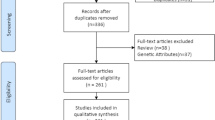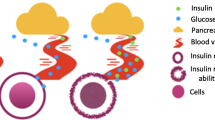Abstract
The interest in the use of neural networks for predicting various diseases has increased in recent years. As type II diabetes is the leading cause of death worldwide, there is a particular emphasis on determining the best neural configurations that can provide high precision and accuracy. Since type II diabetes is considered an epigenetic disease, environmental mediated factors contributing to the development of this disease should be considered for the training of neural networks and its effects. This review article based on the Boolean method aims to compare various prediction methods using neural networks to determine the most favorable features that contribute to its better performance.
Access this chapter
Tax calculation will be finalised at checkout
Purchases are for personal use only
Similar content being viewed by others
References
Joshi, T.N., Chawan, P.M.: Diabetes prediction using machine learning techniques. J. Eng. Res. Appl. 8, 2248–9622 (2018)
Aguiar Salazar, E.D., et al.: Design of a glove controlled by electromyographic signals for the rehabilitation of patients with rheumatoid arthritis. In: Communications in Computer and Information Science, pp. 3–11. Springer Science and Business Media, Berlin (2020)
Coello, G., Gallegos, D.: Economical charge of diabetes. Boletín de Coyuntura 19, 18–20 (2017)
Triantafyllidis, A., et al.: Deep learning in mhealth for cardiovascular disease, diabetes, and cancer: systematic review. JMIR mHealth and uHealth 10(4) (2022)
Abhari, S., Kalhori, S.R.N., Ebrahimi, M., Hasannejadasl, H., Garavand, A.: Artificial intelligence applications in type 2 diabetes mellitus care: focus on machine learning methods. Healthcare Inform. Res. 25(4), 248–261 (2019)
Rehman, A., et al.: Modelling, simulation, and optimization of diabetes type II prediction using deep extreme learning machine. J. Ambient Intell. Smart Environ. 12(2), 125–138 (2020)
Shivananda Nayak, B., et al.: The association of age, gender, ethnicity, family history, obesity and hypertension with type 2 diabetes mellitus in Trinidad. Diab. Metabolic Syndrome: Clin. Res. Rev. 8(2), 91–95 (2014)
Vásquez-Ucho, P.A., Villalba-Meneses, G.F., Pila-Varela, K.O., Villalba-Meneses, C.P., Iglesias, I., Almeida-Galárraga, D.A.: Analysis and evaluation of the systems used for the assessment of the cervical spine function: a systematic review. J. Med. Eng. Technol. 45(5), 380–393 (2021). https://doi.org/10.1080/03091902.2021.1907467
Suquilanda-Pesántez, J.D., Aguiar Salazar, E.D., Almeida-Galárraga, D., Salum, G., Villalba-Meneses, F., Gudiño Gomezjurado, M.E.: “NIFtHool: an informatics program for identification of NifH proteins using deep neural networks. F1000Res 11, 164 (2022). https://doi.org/10.12688/f1000research.107925.1
Kriegeskorte, N., Golan, T.: Neural network models and deep learning. Curr. Biol. 29(7), R231–R236 (2019). https://doi.org/10.1016/J.CUB.2019.02.034
Pereira-Carrillo, J., Suntaxi-Dominguez, D., Guarnizo-Cabezas, O., Villalba-Meneses, G., Tirado-Espín, A., Almeida-Galárraga, D.: Comparison between two novel approaches in automatic breast cancer detection and diagnosis and its contribution in military defense. Smart Innov., Syst. Technol. 255, 189–201 (2022). https://doi.org/10.1007/978-981-16-4884-7_15/COVER
Yanchatuña, O.P., et al.: Skin lesion detection and classification using convolutional neural network for deep feature extraction and support vector machine, vol. 11, no. 3 (2021)
Almeida-Galárraga, D.A., Ros Felip, A., Marco Martínez, F., Serrano-Mateo, L.: Photoelastic analysis of shoulder arthroplasty: current descriptive analysis of research in scientific journals. IFMBE Proc 68(2), 713–717 (2018). https://doi.org/10.1007/978-981-10-9038-7_132
Makroum, M.A., Adda, M., Bouzouane, A., Ibrahim, H.: Machine learning and smart devices for diabetes management: systematic review. Sensors 22(5). MDPI (2022). https://doi.org/10.3390/s22051843
Ganie, S.M., Malik, M.B.: An ensemble machine learning approach for predicting type-II diabetes mellitus based on lifestyle indicators. Healthcare Anal. 2, 100092 (2022). https://doi.org/10.1016/j.health.2022.100092
Dritsas, E., Trigka, M.: Data-driven machine-learning methods for diabetes risk prediction. Sensors 22(14) (2022). https://doi.org/10.3390/s22145304
Vijayashree, J., Jayashree, J.: “Article ID: IJCIET_08_12_069 Cite this Article: J. Vijayashree, J. Jayashree. An expert system for the diagnosis of diabetic patients using deep neural networks and recursive feature elimination. Int. J. Civil Eng. Technol. 8(12), 633–641 (2017). http://iaeme.com/Home/issue/IJCIET?Volume=8&Issue=12http://iaeme.com
Kumari, M., Vohra, R., Arora, A.: Prediction of diabetes using Bayesian network. www.ijcsit.com
Tuppad, A., Patil, S.D.: Machine learning for diabetes clinical decision support: a review. Adv. Comput. Intell. 2(2) (2022). https://doi.org/10.1007/s43674-022-00034-y
Triantafyllidis, A., et al.: Deep learning in mHealth for cardiovascular disease, diabetes, and cancer: systematic review. JMIR mHealth and uHealth 10(4). JMIR Publications Inc. (2022). https://doi.org/10.2196/32344
Ismail, L., Materwala, H.: IDMPF: intelligent diabetes mellitus prediction framework using machine learning. Appl. Comput. Inform. (2021). https://doi.org/10.1108/aci-10-2020-0094
Frimpong, E.A., Oluwasanmi, A., Baagyere, E.Y., Zhiguang, Q.: A feedforward artificial neural network model for classification and detection of type 2 diabetes. J. Phys.: Conf. Ser., IOP Publishing Ltd, (2021).https://doi.org/10.1088/1742-6596/1734/1/012026
Latchoumi, T.P., Dayanika, J., Archana, G.: A comparative study of machine learning algorithms using quick-witted diabetic prevention (2021). http://annalsofrscb.ro
Tirado, A., Cambra, U.C., Martinez Martinez, L.: Health communication View project Edu-entertainment and Health Education View project (2020). https://www.researchgate.net/publication/347975086
Nai-Arun, N., Moungmai, R.: Comparison of classifiers for the risk of diabetes prediction. Procedia Comput. Sci., Elsevier B.V., pp. 132–142 (2015). https://doi.org/10.1016/j.procs.2015.10.014
Olisah, C.C., Smith, L., Smith, M.: Diabetes mellitus prediction and diagnosis from a data preprocessing and machine learning perspective. Comput. Methods Programs Biomed. 220 (2022). https://doi.org/10.1016/j.cmpb.2022.106773
Zia, U.A., Khan, N.: Predicting diabetes in medical datasets using machine learning techniques. Int. J. Sci. Eng. Res. 8(5) (2017). http://www.ijser.org
Kho, A.N., et al.: Use of diverse electronic medical record systems to identify genetic risk for type 2 diabetes within a genome-wide association study. J. Am. Med. Inform. Assoc. 19(2), 212–218 (2012). https://doi.org/10.1136/amiajnl-2011-000439
Patil, S.D., Deshmukh, J.S., Patil, C.R.: Social factors influencing diabetes mellitus in adults attending a tertiary care hospital in Nagpur: a cross sectional study. Int. J. Res. Med. Sci. 5(11), 4988 (2017). https://doi.org/10.18203/2320-6012.ijrms20174957
Rajendra, P., Latifi, S.: Prediction of diabetes using logistic regression and ensemble techniques. Comput. Methods Programs Biomed. Update 1, 100032 (2021). https://doi.org/10.1016/j.cmpbup.2021.100032
Bin Huang, G., Zhu, Q.Y., Siew, C.K.: Extreme learning machine: theory and applications. Neurocomputing 70(1–3), 489–501 (2006). https://doi.org/10.1016/j.neucom.2005.12.126
Sharma, T., Shah, M.: A comprehensive review of machine learning techniques on diabetes detection. Visual Comput. Industry, Biomed., Art 4(1). Springer (2021). https://doi.org/10.1186/s42492-021-00097-7
Meng, X.H., Huang, Y.X., Rao, D.P., Zhang, Q., Liu, Q.: Comparison of three data mining models for predicting diabetes or prediabetes by risk factors. Kaohsiung J. Med. Sci. 29(2), 93–99 (2013). https://doi.org/10.1016/j.kjms.2012.08.016
Ahuja, R., Sharma, S.C., Ali, M.: A diabetic disease prediction model based on classification algorithms. Annals Emerg. Technol. Comput. 3(3), 44–52 (2019). https://doi.org/10.33166/AETiC.2019.03.005
Liu, Q., et al.: Predicting the risk of incident type 2 diabetes mellitus in Chinese elderly using machine learning techniques. J. Pers. Med. 12(6) (2022). https://doi.org/10.3390/jpm12060905
Ismail, L., Materwala, H., Tayefi, M., Ngo, P., Karduck, A.P.: Type 2 diabetes with artificial intelligence machine learning: methods and evaluation. Arch. Comput. Methods Eng. 29(1), 313–333 (2022). https://doi.org/10.1007/s11831-021-09582-x
Sisodia, D., Sisodia, D.S.: Prediction of diabetes using classification algorithms. Procedia Comput. Sci., Elsevier B.V., 1578–1585 (2018). https://doi.org/10.1016/j.procs.2018.05.122
Khanam, J.J., Foo, S.Y.: A comparison of machine learning algorithms for diabetes prediction. ICT Express 7(4), 432–439 (2021). https://doi.org/10.1016/j.icte.2021.02.004
Battineni, G., Sagaro, G.G., Nalini, C., Amenta, F., Tayebati, S.K.: Comparative machine-learning approach: a follow-up study on type 2 diabetes predictions by cross-validation methods. Machines 7(4) (2019). https://doi.org/10.3390/machines7040074
Valizadeh, A., Jafarzadeh Ghoushchi, S., Ranjbarzadeh, R., Pourasad, Y.: Presentation of a segmentation method for a diabetic retinopathy patient’s fundus region detection using a convolutional neural network. Comput. Intell. Neurosci. 2021 (2021). https://doi.org/10.1155/2021/7714351
Alehegn, M., Joshi, R., Mulay, P.: Analysis and prediction of diabetes mellitus using machine learning algorithm. http://www.ijpam.eu
Alvarado-Cando, O., Torres-Salamea, H., Almeida, D.A.: UDA-µBioLab: teaching microcontrollers with bioinstrumentation. IFMBE Proceedings. Springer, pp. 877–880 (2019). https://doi.org/10.1007/978-981-10-9035-6_163
Sonia, J.J., Jayachandran, P., Md, A.Q., Mohan, S., Sivaraman, A.K., Tee, K.F.: Machine-learning-based diabetes mellitus risk prediction using multi-layer neural network no-prop algorithm. Diagnostics 13(4), 723 (2023). https://doi.org/10.3390/diagnostics13040723
Tirado-Espín, A., et al.: Tik-Tok and Twitter: influence of social networks in the general elections of Ecuador 2021. Smart Innov., Syst. Technol. 318, 227–236 (2023). https://doi.org/10.1007/978-981-19-6347-6_20
Author information
Authors and Affiliations
Corresponding author
Editor information
Editors and Affiliations
Rights and permissions
Copyright information
© 2024 The Author(s), under exclusive license to Springer Nature Singapore Pte Ltd.
About this paper
Cite this paper
Tualombo, M. et al. (2024). The Use of Neural Networks for the Prediction of Type II Diabetes: A Comparison of Recent Advances and Perspectives. In: Ibáñez, D.B., Castro, L.M., Espinosa, A., Puentes-Rivera, I., López-López, P.C. (eds) Communication and Applied Technologies. ICOMTA 2023. Smart Innovation, Systems and Technologies, vol 375. Springer, Singapore. https://doi.org/10.1007/978-981-99-7210-4_4
Download citation
DOI: https://doi.org/10.1007/978-981-99-7210-4_4
Published:
Publisher Name: Springer, Singapore
Print ISBN: 978-981-99-7753-6
Online ISBN: 978-981-99-7210-4
eBook Packages: Intelligent Technologies and RoboticsIntelligent Technologies and Robotics (R0)




